LEAP Technology Has Developed A Kind of Sensor – Based on WACKER ELASTOSIL® Silicone Films

Smart Materials
Integrated sensors turn articles of clothing into truly high-tech garments that can monitor your breathing or map your movements on a computer screen. With support from WACKER, Danish start-up LEAP Technology has developed just this kind of sensor – based on ultrathin silicone films and conductive silicone elastomers.
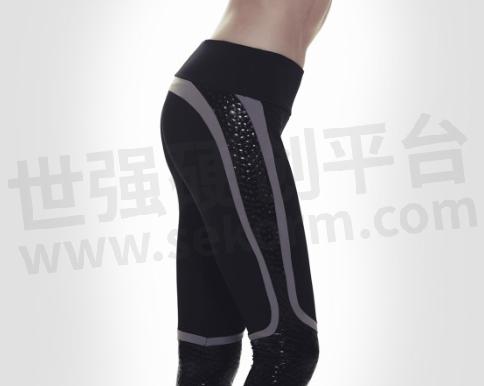
The sports shirt hugs her torso like a second skin, registering the pilates student’s every movement without her noticing a thing. The highly accurate sensors constantly transmit data over a Bluetooth connection to a smartphone, whose software detects incorrect movements, protecting the athlete from muscle tears or inflammations – even when she is working out in her living room, where there is no instructor to monitor whether she is doing the exercises correctly.
Smart textiles – textiles with integrated sensors intended to make the clothing of the future more intelligent – are opening up new growth opportunities in the athletic apparel, consumer electronics, and medical technology industries. Market researchers at IDTechEx estimate that total global sales of wearable technologies – of which smart textiles account for an ever-increasing share – will reach approximately €12 billion this year and roughly €70 billion by 2025.
Benefits for Rehab Patients
There is virtually no limit to the potential applications of this technology. For gamers, sensors on the body can transmit movements onto a screen, allowing players to compete in a sword fight with a virtual opponent. Like yoga or pilates instructors, physical therapists can also use integrated sensors, in this case, to determine whether rehab patients are performing their therapy exercises exactly as prescribed.
“This kind of wearable technology offers a number of advantages, especially in rehabilitation or for long-term patients,” says Renate Glowacki, an applications chemist for silicone films at WACKER. “The materials work around the clock, imperceptibly monitoring processes like swelling or respiratory movement, and warning the wearer or the treating physician if the patient’s health is threatened.”
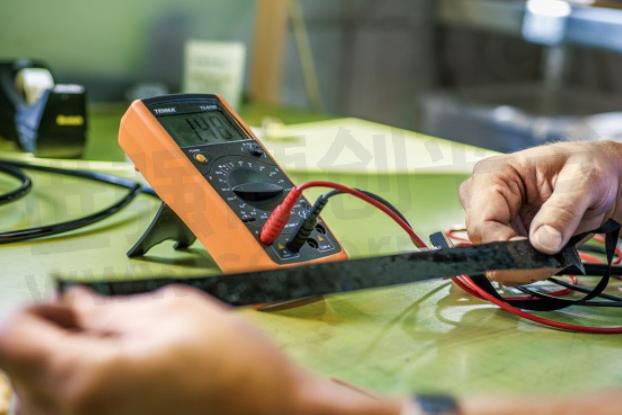
Electroactive elastomers made by LEAP Technology undergo a test: a power source is attached to the coated silicone film.
Highly sensitive mini sensors are at the heart of smart clothing. “Textiles are the interface between the individual and their environment,” explains Dr. Rahimullah Sarban, founder of LEAP Technology, a Danish company currently producing sensor components and parts for manufacturers of smart textiles and for other industries. “That makes integrating sensor elements into clothing pretty much the perfect way of detecting the wearer’s movements and bodily functions – his biomechanics.”
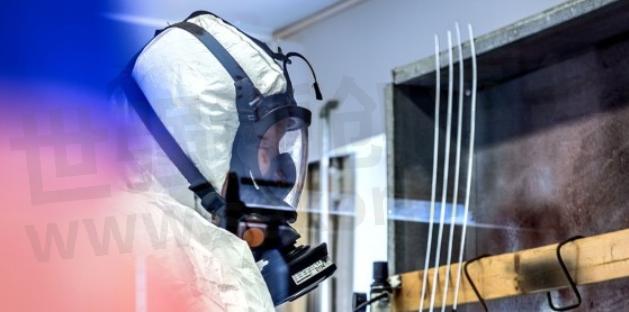
Production of electroactive elastomers: the silicone film is coated with a layer containing a silicone filled with carbon black so that it is conductive and functions as an electrode.
Sandwiched Between Electrodes
These kinds of elastic sensors are made possible through the use of innovative materials such as electroactive polymers (EAPs), which are based on silicone rubber films. ELASTOSIL Film is the brand name under which WACKER markets these ultrathin films, which are only 20 to 200 microns thick (the diameter of a human hair, by comparison, is roughly 70 microns). The film is sandwiched between two electrodes – electrodes that can be made of WACKER silicone elastomers filled with carbon black to make them electrically conductive. In other words, all three layers are made of elastic materials. “If you press these elements together like a sandwich or if you stretch the material lengthwise, that movement will produce a detectable change in capacitance. The basic sensor unit is nothing other than an elastic capacitor,” Glowacki points out. ®
Geared for Marketability
The actual technology has been in existence since the 1990s, and WACKER is among those companies that have been working with EAPs for some time. “But now the leap to industrial production is becoming a reality,” emphasizes Susanne Neueder, Global Marketing Manager for silicone films. That leap requires a market, and innovative start-ups like LEAP Technology.
When WACKER representatives met the LEAP Technology team at the 2014 EuroEAP Conference in Linköping, Sweden, the WACKER project managers were impressed by the determination of the Danish start-up to forge ahead with creating EAP components and manufacturing them on an industrial scale. “And thanks to WACKER, we now have a valuable partner on board – our areas of expertise complement each other perfectly,” says LEAP Technology founder Dr. Sarban. “ELASTOSIL Film is an outstanding material that is perfectly suited to our needs” – and one that can be used for manufacturing highly accurate sensors. “At the same time, WACKER silicone elastomers are immune to power surges and to electrical or physical shocks,” Sarban observes. ®
In building their components, lab experts at LEAP Technology use both silicone films and a further WACKER silicone rubber that has been modified for conductivity. LEAP team members then hook up the unit to electrical wiring and a textile mechanical attachment. “The last step is to embed this entire unit within another WACKER silicone to protect it from electrical interference and to obtain the desired surface,” Sarban explains. Before the components are sent on to customers, they are tested and calibrated at the Leap Technology laboratories.

On account of their excellent dielectric properties, ELASTOSIL® silicone films are LEAP Technology’s product of choice for its sensors.
Numerous Other Applications
In early 2014, electroactive polymers were added to what WACKER calls its New Solutions projects, a cross-divisional, interdisciplinary category that the Group has created for grouping together promising products and technologies. The team has grown steadily and Dr. Andreas Köllnberger received the 2015 Alexander Wacker Innovation Award for developing the film production process. “Smart textiles aren’t the only interesting application for EAPs,” Köllnberger emphasizes. “Intelligent sensors allow production employees to reliably operate industrial manufacturing processes based on human-machine communication. Electroactive polymers are also suitable for use as actuators in electronic, automotive and automation technologies, or as electricity generators – in other words, for anything relating to energy harvesting.”
The key to their material characteristics lies in the chemical properties of the silicones. “Proper crosslinking plays a special role,” Glowacki notes. The molecular structure is what allows individual polymer chains to move as well as they do, yielding films that are extremely extensible, but that can resume their original shape – without wearing out. “In order to produce ultrathin silicone films at the level of quality we need, WACKER has developed a complex process and applied to have it patented,” Glowacki explains. “Plus, producing these films has been an important way for us to reach out to manufacturers of EAP components.”
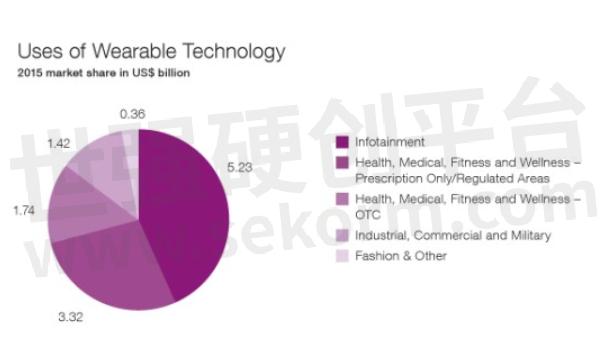
Source: IDTechEx Research, 2015
Sensor Design and Measurement Principle
In order to ensure that these precision silicone rubber films are pure and free of particle contamination, and that they can meet customers’ actuation and energy harvesting requirements, WACKER uses a continuous production process under cleanroom conditions. The process is already up and running in a small-scale plant, with full-scale production planned for the medium term. The first step involves applying the addition-curing silicone rubber compounds in a way that yields the desired ultrathin films at the highest possible level of purity. A major advantage here is that no solvents are required. The next step is to apply heat, which crosslinks the polymer chains and fixes the shape of the film. WACKER experts have also integrated a quality-control stage into the manufacturing process: “We take optical and ultrasound measurements to make sure that the layer thickness doesn’t vary by more than 5% across the entire surface,” Glowacki explains. ELASTOSIL Film is also available as a continuous roll, a format that rival production processes are unable to achieve. ®
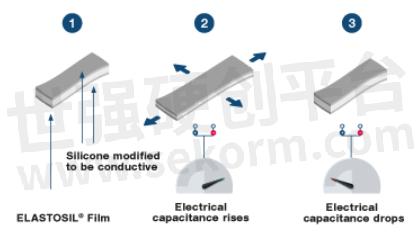
A power source is attached to the conductively coated silicone film (1). If the film is deformed mechanically, the surface (2) changes or increases in size, resulting in altered capacitance. If the film relaxes again in that the pressure is relieved (3), the surface – and hence the capacitance – changes once more.
Maintenance-Free Components
Yet another advantage is that ELASTOSIL Film products have all of the essential properties that otherwise characterize silicones: heat resistance, low-temperature flexibility, excellent dielectric properties and outstanding resistance to a large number of physical and chemical forces. “Their outstanding elastic properties are part of the reason why silicone films don’t wear out – even after years of mechanical stress,” Glowacki adds. “And that makes EAP components maintenance free.” ®
LEAP Technology is still producing EAP components either by hand or using partially automated processes. “Processing these ultrathin, soft, highly flexible silicone films is a challenge for our machines, but we are making good progress toward fully automated component fabrication,” Sarban explains. “That’s the only way we can meet our goal of reliably producing thousands of units per month,” observes the LEAP director.
Examples of electroactive-polymer-based sensors manufactured by LEAP Technology.

This positions LEAP Technology in the gap that currently exists between the product manufacturers and companies like WACKER, who make the materials. “This is precisely where we need companies that offer EAP components,” says Marketing Manager Susanne Neueder. “Not only does this meet sensor users halfway – it also helps establish a supply chain.”
“Thanks to their outstanding elastic properties, silicone films don’t wear out – even after years of mechanical stress.”Renate Glowacki, Application Technology, WACKER SILICONES.
Inquiries on the Rise
The experts at LEAP Technology have already received some 120 requests for information from sources that include multinational corporations, small businesses, and universities. As Sarban notes, “Examples of our partners include Ohmatex, Electricfoxy, several other similar companies, and some Danish universities.”
Having a reliable supply chain for the materials and individual components is a focus of every customer meeting. “WACKER is an important partner – capable of producing large quantities of silicone films,” explains Sarban. This partnership generates trust, he added, ensuring reliability along the entire supply chain.
Collaboration between these companies has set the stage for a future in which high-tech fabrics hug our skin – and sharpen our awareness of our health.

Textile-based sensors convert mechanical energy into electricity, enabling them to capture body movements.
- +1 Like
- Add to Favorites
Recommend
- WACKER Launches The Liquid Silicone Rubbers ELASTOSIL® LR 3003/90 With a Hardness of 90, Measured in Shore A
- WACKER Has Produced A Liquid Silicone Rubber (LSR) ELASTOSIL® LR Series for 2K Injection Molding
- WACKER ELASTOSIL® LR Liquid Silicone Rubber Featured with An Improved Fire Protection,Which Means Increasing Safety
- WACKER Presents Silicone Materials for Enhancing the Safety of Lithium-Ion Batteries
- WACKER Engineering Silicones Tech Center in Burghausen
- WACKER Presents Silicone Resins SILRES® H60 A/B and SILRES® H62 C for the Impregnation of Electric Motors
- WACKER Presents Highly Adhesive Silicone Gel for Fixing Electronic Components at COMPAMED 2023
- WACKER’s Polysilicon Production Successfully Certified to IATF 16949
This document is provided by Sekorm Platform for VIP exclusive service. The copyright is owned by Sekorm. Without authorization, any medias, websites or individual are not allowed to reprint. When authorizing the reprint, the link of www.sekorm.com must be indicated.





























































































































































































































































































































































































































































































































































































































































































































































































































































































